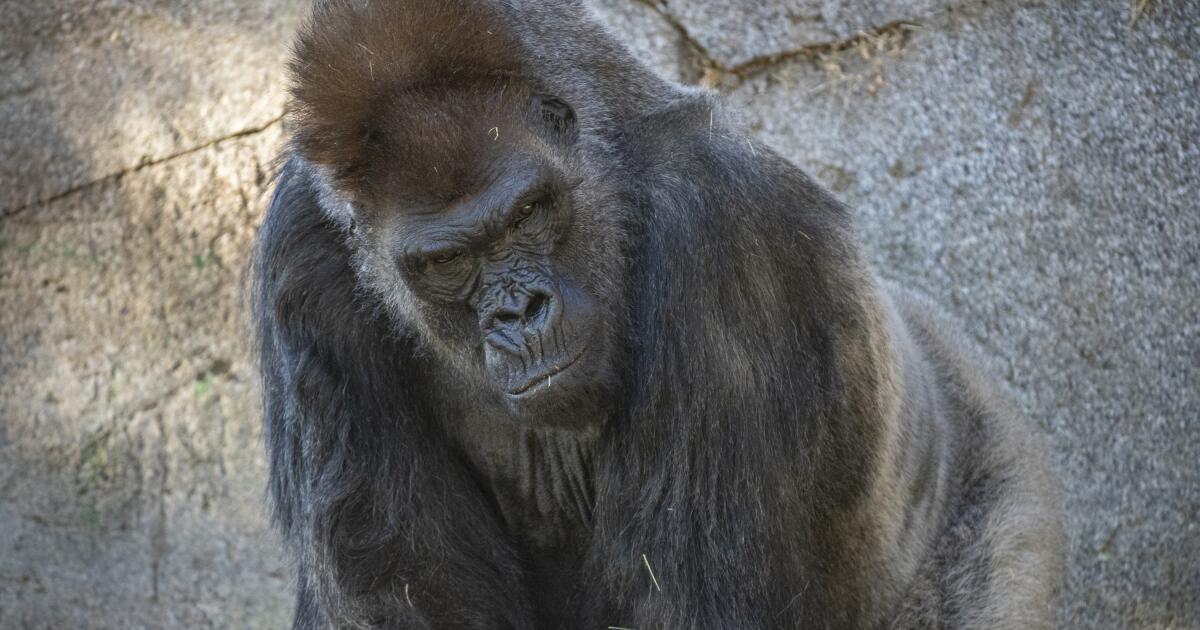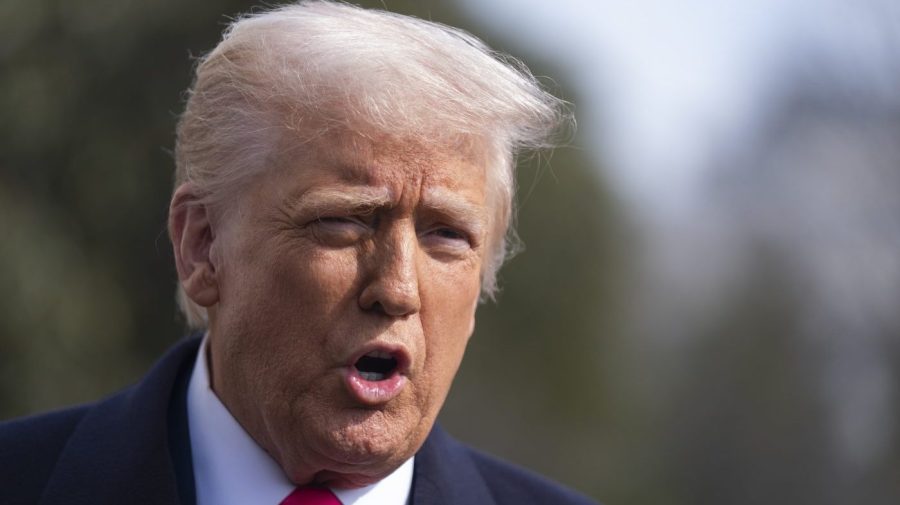
At 51, Winston is the second-oldest living male gorilla in a U.S. zoo and has the creaky joints and cardiac issues to prove it.
Despite his advanced age and declining health, he remains the leader of a five-member gorilla troop at the San Diego Zoo Safari Park. Long known for his compassionate, calm demeanor, he’s still able to keep troop members in line even as he’s slowing down.
“He is still playing the role of a silverback. It is one of those behaviors that is established over the years,” said Matt Kinney, interim director of veterinary services. “The troop will certainly react if he gives them a glance or moves in their direction. Anytime I’ve been up there, he’s still maintaining control of that troop.”
Kristi Burtis, Safari Park’s vice president of wildlife care, has noted Winston’s decline the past four years she’s been at the park — “you can just tell, he’s an elderly gorilla” — but says he’s still “a phenomenal animal.”

Winston is the second-oldest male western lowland gorilla in U.S. zoos.
(San Diego Zoo Wildlife Alliance )
Winston is an endangered western lowland gorilla, one of just 343 in the U.S. Born in the wild, he came to the 1,800-acre park located near Escondido in 1984 from a private owner in England. While here, he’s fathered nine offspring — and is grandfather to eight and great-grandfather to one.
These days he takes a beta blocker and other cardiac medications, as well as supplements and analgesics to ease his joint pain. Kinney, who has been Winston’s primary veterinarian since 2021, checks on him in person at least once every two weeks.
Zoo officials say wildlife geriatric care is a relatively new field and an important one, as animals in zoos like Winston live longer. The median life expectancy for male gorillas in captivity is nearly 33 years old and 39 for female gorillas, according to records kept by the Gorilla Species Survival Plan, which manages gorilla care in U.S. zoos.
The oldest living gorilla in captivity is Fatou, a 66-year-old female at Zoo Berlin. The oldest male is a gorilla named Ramses, who lives at the Fort Worth Zoo and turned 52 in April, said Kristen Lukas, who works at the Cleveland Metroparks Zoo and is chair of the species survival plan.
The goal of the plan is to maintain a healthy, genetically diverse and demographically stable population of gorillas and there is a population target of 350 gorillas. This past year, the group recommended 50 pairs breed over the next two years, she said.
It was back in 2017 that vets first realized Winston had some heart function irregularities. Keepers had noticed Winston was more lethargic than usual and had a decreased appetite. After running a series of diagnostic tests, including an echocardiogram, veterinarians addressed “immediate clinical concerns” and established a baseline for his cardiac care.

Winston the gorilla underwent medical tests in 2017, seen here in this screengrab from video shot at San Diego Zoo Safari Park.
(U-T file)
Kinney said older great apes, particularly male gorillas, are susceptible to heart disease.
In early 2021, Winston had another health scare when he and other members of his troop tested positive for COVID-19, apparently spread to the apes by an infected animal care staffer.
All the apes eventually recovered, with Winston being given monoclonal antibody therapy, a synthetic defense against COVID-19, which zoo officials said was crucial.
Because of his age and heart history, a medical team including cardiologists, anesthesiologists and veterinary specialists worked together to evaluate Winston over a six-month period and found he had dental issues as well as cardiac and kidney problems. Some of his teeth were pulled.
Winston was started on cardiac medications and fitted with a cardiac monitor, about the size of a flash drive, which was implanted just under the skin in his chest. Just this past week, Winston underwent a procedure and the implant was switched out for a new one.

Winston was born in the wild and has lived at San Diego Zoo Safari Park since 1984.
(San Diego Zoo Wildlife Alliance )
By waving a handheld machine from about 2 feet away, care staff can download information about his heartbeat and activity levels every day. Kinney said he uses that information to tinker with his cardiac medication. “It has been really helpful to have that inside look at a patient and to be able to monitor and make adjustments day to day and week to week,” Kinney said.
Also keeping track of Winston’s heart health is the Great Ape Heart Project, a cardiac health initiative that includes people who care for gorillas in zoos. The hope is that lessons learned from Winston might help other gorillas.
While vet staffers monitor what Kinney calls “expected geriatric health concerns,” animal-care staffers do what they can to keep Winston comfortable in his habitat. They’re providing him with extra bedding. He and the other gorillas have the option to stay indoors on cold or rainy days. The whole troop is brought indoors each night.
Zoo officials say Winston is a favorite among guests and animal-care workers. His gentle demeanor is so well known that when a new keeper joins the gorilla team, they start out by working with Winston.
His kindness extends to other gorillas as well. Earlier in his life, Winston accepted — basically adopted — two unrelated male gorillas in his troop, an approach many silverbacks wouldn’t have taken. “There aren’t very many silverbacks living in human care that would be accepting of an unrelated male coming into their troop — and that experience happened twice,” noted Burtis, the wildlife care official.
Burtis said Winston is a special gorilla who “chooses to lead the troop with his heart” and displays behavior that “represents compassion.”
When he examines Winston, Kinney said he gives the 450-pound ape special treats like prunes, which helps him stay “relaxed, calm and gentle” during their interactions.
“I’m not sure if he recognizes me, but he probably knows it is the vet with no hair (who) always feeds prunes to him. So in that regard, that’s probably why he’s accepting and why we have a good relationship,” Kinney said.
“It really has been a privilege to be able to work with him for so many years.”

Winston, left, and Imani are two gorillas in a family troop at San Diego Zoo Safari Park.
(San Diego Zoo Wildlife Alliance )
As Winston slows down, there is planning going on behind the scenes for the inevitable — including coming up with a succession plan. Troops only have one silverback, the name for breeding males that have reached sexual maturity.
Winston’s troop is made up of three adult females and two young females. There’s also two bachelor male gorillas at Safari Park who are kept in a different habitat. At the San Diego Zoo, there are five males and one female.
For now, officials haven’t said how they’ll replace Winston.
“Right now there wouldn’t be anyone that’s in the troop to take over that position of a silverback… so that’s something that’s being worked on,” Kinney said. “We know Winston is a beloved animal, but every animal is going to pass at some point.”




